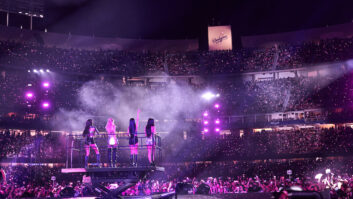
Despite the hoopla surrounding the biggest reunion tour of the year,
I figured this gig couldn’t be too tough — just a couple of
folksingers, right? Actually, Paul Simon had a few surprises for his
“Old Friends” performances with Art Garfunkel, and from any
standpoint, this was no ordinary tour.
With a hot seven-piece electric band
(drums/bass/guitars/keys/percussion), cello, mandolin, theremin and
slide didgeridoo, as well as Simon switching between a Strat and four
wireless acoustic guitars, there were a whole lotta input channels
going on: 60 in all, plus effects returns. And if that weren’t enough
to keep track of, the two-and-a-half-hour, no-intermission show also
featured Simon bringing in the Everly Brothers to play some of their
hits.
Handling front-of-house duties was veteran David Morgan, who came
onboard after wrapping up this year’s Steely Dan tour. After 17 years
of working with Simon, Morgan likes the challenge of creating what he
terms “living room” mixes in what were once considered
less-than-ideal venues. Although, he adds that “many modern
arenas are great-sounding rooms. Mixing in arenas is far more than
acceptable — it’s not an artistic compromise anymore.”
However, Morgan is quick to admit that improved technologies have
also helped, especially this show’s Crest QSC-powered, 44-box Clair i4
line array system (and 40 single-18 i4b subs), which he calls “a
great P.A. and a wonderful tool.” Morgan is equally enthusiastic
about the Clair i/O loudspeaker control system, which he can manipulate
from anywhere in the house via a Gateway wireless tablet. “This
is what we engineers have dreamed about for years,” Morgan notes.
“The line array columns are divided into multiple control zones,
allowing me to dial in uniform response throughout the arena. While
tuning the system, I walk everywhere in the building to make sure every
patron will get optimal audio delivery.”

Morgan had his choice of toys for house processing, and after the
Shure Beta 87C on Simon and Garfunkel’s voices, the vocal chain
included Tube-Tech CL2A compressors; two Lexicon 224Ls and a 480L for
reverb; a TC Electronic 2290 for delay and slap; and a hint of Eventide
H3500 UltraHarmonizer to spread the vocal image out in stereo. Other
rack denizens included a TC Electronic M5000 on acoustic guitars, TC
A4000s for drums and piano, dbx 160L limiters (“There’s nothing
better on electric guitars,” says Morgan) and Summit DCL-200
compressors used to smooth warming RF signals from the acoustic
guitars. Morgan adds that wireless systems for acoustic guitars (due to
their wide dynamic range) are more critical than with electrics. One
solution was using Samson wireless on acoustics: “They’re the
only one that can really take a slam strum,” he explains,
“especially with Fishman [pickups] and all their high
end.”
The one thing that truly had Morgan excited about this tour was
debuting the first of Yamaha’s new PM5000 high-performance analog
consoles on the road. Along with all-new redesigned mic preamps and
EQs, the board features 52 inputs, 35 mix buses, 12 VCAs, a 16×37
matrix and 1,000-scene recall, yet Morgan needed a few more inputs, so
he used an 02R digital mixer as a sidecar to handle 13 inputs from
percussionist Jamey Haddad. Morgan could simply load in a data disk of
settings he’s used working with Haddad since 1999 as starting points
and tweak from there.
Morgan found the PM5000 to be a tweaker’s delight. During a
soundcheck, I noticed that he had every channel EQ on the board active.
“To achieve a natural sound with close-miking, you need to use a
lotta knobs, especially when dealing with all that proximity
effect,” says Morgan. “Judicious use of EQ helps me create
a space for each sound source so it stands out in the mix without
unnecessary volume increases.” Morgan was especially impressed
with the console’s sound, which reminded him of “a ’70s Harrison
studio board or an old Alive: sweet-sounding mic preamps and very
smooth EQ.” Morgan notes that he used to travel with outboard
preamps, especially to handle the low end of kick drum and direct or
miked bass. “There’s no need for that with the PM5000 — the
bass is incredibly tight, and there’s absolutely none of that 8k to
10kHz high-end graininess.
“It’s really good-sounding analog, with a reasonable amount of
digital control and ergonomics that have a familiar PM4000 feel.”
But besides having four extra VCA groups, Morgan also liked the little
touches, from the 12 stereo sends to the new muting system, which
blinks to show the next mute group.
There was one drawback to the PM5000, Morgan notes: “With all
its motorized faders, beefed-up frame and logic circuits, it’s quite a
bit heavier than a PM4000. It’s a six-guy lift!” But aside from
that, Morgan was enthusiastic about the board. “Yamaha has done a
great job of evaluating the needs of front-of-house engineers, and with
the PM5000’s four stereo and eight mono matrix outs, it could be a
great monitor board, as well.”






